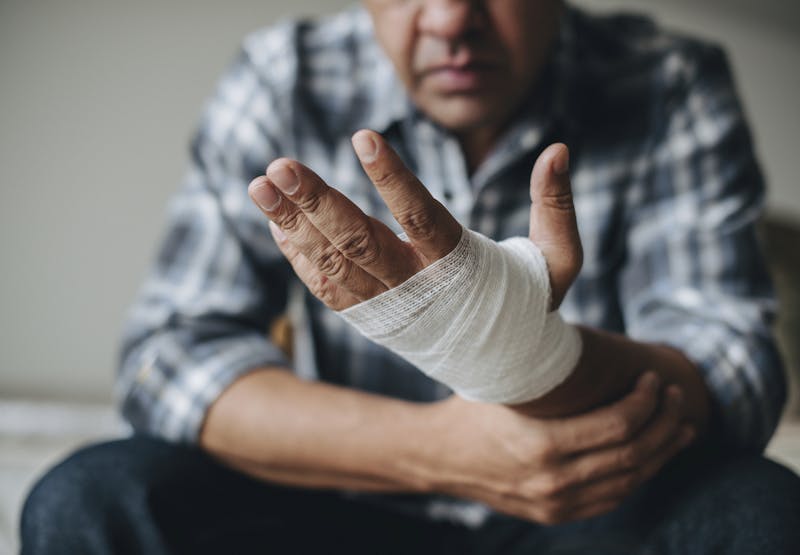
Today, patients are more informed of current and past regenerative treatments because they literally have AI search engines at their fingertips. Greco Medical Group has been at the forefront of regenerative medicine the past 25 years, and the purpose of this post is to explain the various Autologous (same donor same recipient) treatments available and compare the differences.
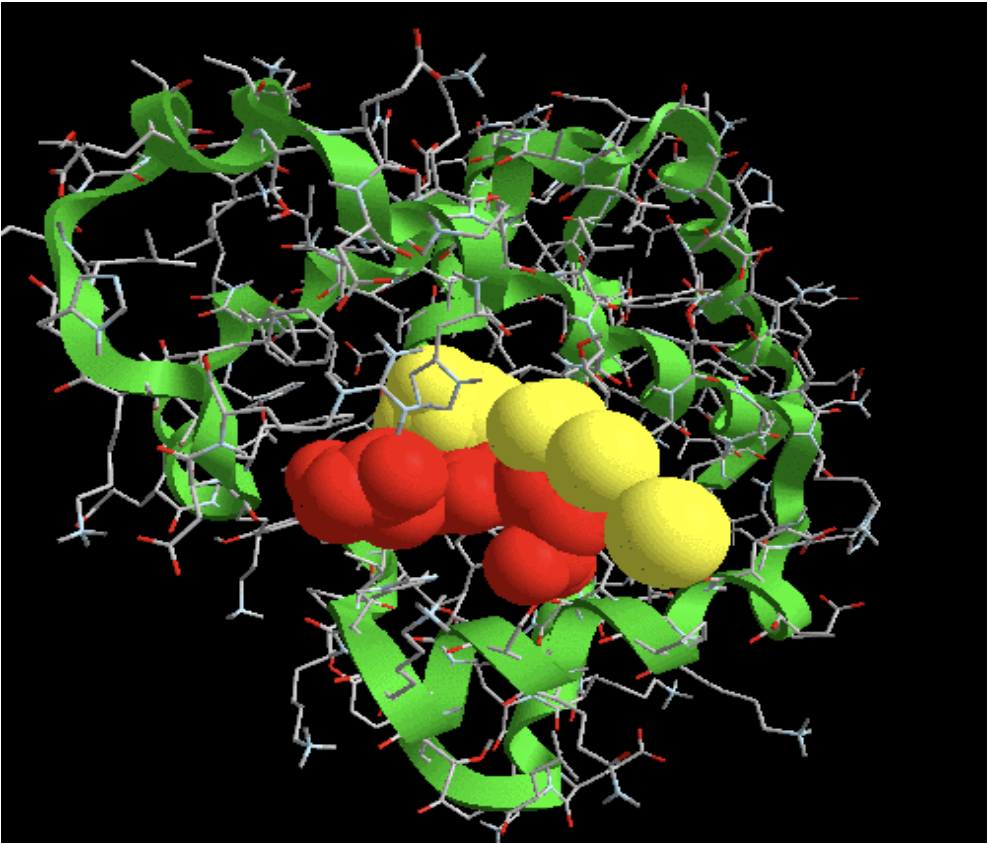
What is Autologous Cytokine-Rich Serum (ACRS)?
Autologous cytokine-rich serum (ACRS) is an emerging biological therapy that harnesses the body’s own healing mechanisms to treat a wide variety of inflammatory and degenerative conditions. Rooted in the principle of regenerative medicine, ACRS utilizes a patient’s blood, processed to concentrate beneficial cytokines and growth factors, and then re-injected into the body at specific sites of injury or inflammation. This approach is gaining traction in both human and veterinary medicine, particularly in orthopedics, sports medicine, dermatology, and rheumatology.
Production of Autologous Cytokine-Rich Serum
The process begins by carefully selecting patients who may benefit from regenerative interventions. Suitability is determined based on clinical diagnosis, severity of disease, and patient health status, ensuring that no contraindications such as ongoing infection or blood-borne diseases are present. Prior to blood collection, patients are usually advised to avoid medications or supplements that might impact platelet or cytokine function, such as non-steroidal anti-inflammatory drugs (NSAIDs).
After collection, the tubes containing the blood are incubated at 37°C (approximately body temperature) for a defined period, often 6 to 24 hours. The presence of activating substrates (such as glass beads) in the tubes stimulates the white blood cells, particularly monocytes, to produce and secrete a rich array of anti-inflammatory cytokines and growth factors. This step is essential for enhancing the concentration of bioactive molecules that will become the therapeutic agent.
The Molecular Profile of ACRS
ACRS is characterized by a high concentration of anti-inflammatory cytokines such as interleukin-1 receptor antagonist (IL-1Ra), interleukin-10 (IL-10), and transforming growth factor-beta (TGF-β). It may also contain anabolic growth factors including platelet-derived growth factor (PDGF) and insulin-like growth factor-1 (IGF-1). Crucially, unlike platelet-rich plasma (PRP), ACRS is specifically designed to maximize anti-inflammatory and regenerative cytokines rather than platelets or other blood cells.
Benefits of Autologous Cytokine-Rich Serum
- Anti-Inflammatory Effects: One of the most significant benefits of ACRS is its potent anti-inflammatory action. Cytokines such as IL-1Ra competitively inhibit pro-inflammatory cytokines like interleukin-1, which play a central role in the pathogenesis of osteoarthritis, tendonitis, and other degenerative diseases. By dampening the inflammatory cascade, ACRS may alleviate pain, swelling, and stiffness, offering a natural alternative to corticosteroids and NSAIDs.
- Promotion of Tissue Healing and Regeneration: ACRS is also rich in growth factors that can stimulate cellular repair processes. These bioactive molecules promote migration, proliferation, and differentiation of local stem and progenitor cells, encouraging the regeneration of cartilage, tendon, skin, or other target tissues. This is particularly valuable in conditions where tissue integrity is compromised, such as after sports injuries or in chronic degenerative diseases.
- Reduced Risk of Immunogenicity and Adverse Reactions: Because ACRS is derived from the patient’s own blood (autologous), the risk of immune rejection or allergic reaction is minimal. This stands in contrast to treatments using donor-derived or synthetic compounds, which may carry a risk of sensitization or transmission of infectious agents.
- Versatility Across Medical Disciplines: The application of ACRS is not confined to a single branch of medicine. Its use is well-documented in:
- Orthopedics: Treatment of osteoarthritis, tendonitis, ligament injuries, and muscle strains.
- Sports Medicine: Accelerating healing and return-to-play in athletes with acute or chronic injuries.
- Dermatology: Enhancing wound healing, scar revision, and skin rejuvenation procedures.
- Rheumatology: Mitigating symptoms of inflammatory joint and soft tissue disorders.
- Veterinary Medicine: Managing joint and tendon pathologies in horses and companion animals.
- Potential to Delay or Reduce Need for Surgery: By addressing the root causes of inflammation and tissue degradation, ACRS therapy may reduce or delay the need for surgical intervention. For example, in early to moderate osteoarthritis, patients treated with ACRS often report improved function and decreased pain, sometimes postponing or avoiding joint replacement surgery.
- Minimal Side Effects and Rapid Recovery: The procedure for ACRS therapy is minimally invasive and typically well-tolerated. Most patients experience little to no downtime, with side effects mostly limited to mild soreness or swelling at the injection site. The risk of infection is minimized by sterile technique and the autologous nature of the serum.
Back to the Future: A Comparison with our regenerative therapies
It is important to distinguish ACRS from other blood-based therapies such as PRP and autologous conditioned serum (ACS). While PRP concentrates platelets to harness their growth factors, ACRS aims specifically to boost anti-inflammatory cytokines, making it especially suitable for chronic inflammatory and degenerative conditions.
What is Platelet Rich Plasma (PRP)?
According to Marks (2001), whole blood is considered concentrated, Platelet Rich, when the platelet count reaches four times the baseline in 5 milliliters of blood. ( Not all Systems achieve this threshold)
PRP contains RBC’s, WBC’s and Platelets.
Platelets contain healing regenerative proteins called growth factors
What is Cytokine Rich Plasma (CRP)? Our proprietary regenerative treatment…
In simpler terms, Cytokine Rich Plasma (CRP) “is a “purer grade” of your own your regenerative proteins and anti-inflammatory cytokines”.
- It also contains “more regenerative proteins or natural growth factors from the platelets, that centrifuges cannot capture”
- Is devoid of the more inflammatory cells (WBC’s), and (RBC’s) that are not needed, additionally, RBC’s cause more pain when injected into joint and tendon/ligament.
- Our unique proprietary process does not require “incubation for 6 to 24 hours” like ACRS
Therefore, CRP has the advantages because “it is purer, has more growth factors, less pro-inflammatory cells (WBC’s) than PRP and the anti-inflammatory cytokines as in ACRS”.
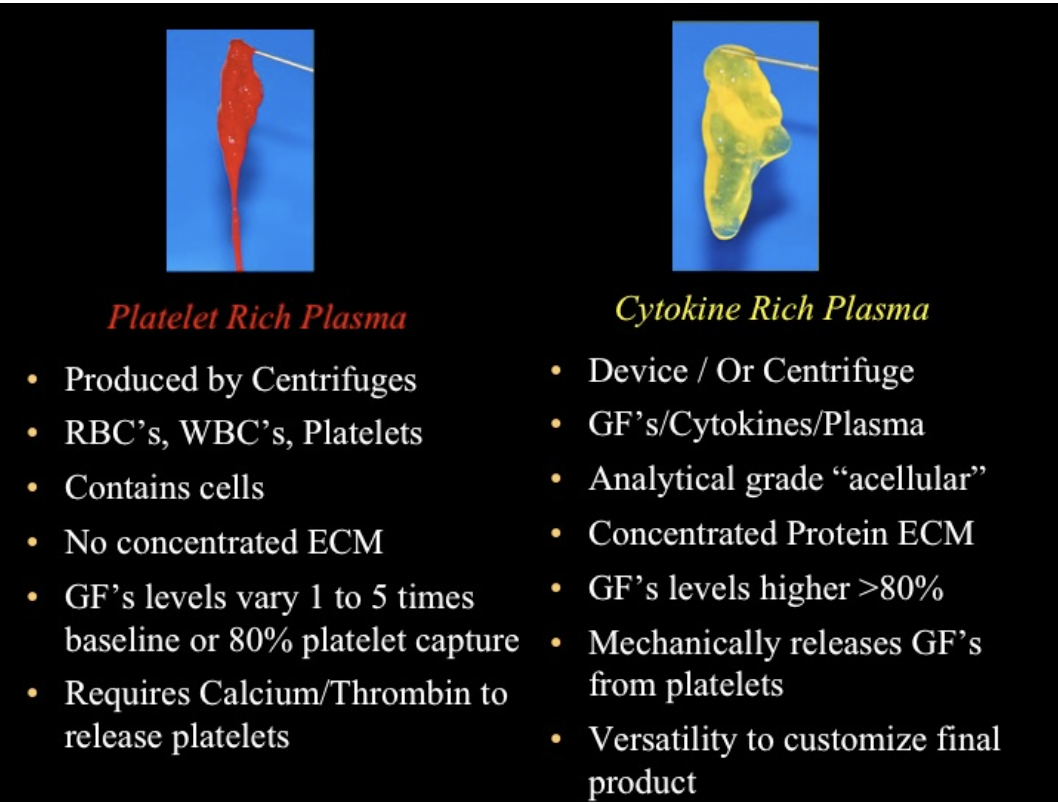
Why is CRP more effective than PRP in Orthopedic treatments?
CRP has advantages in non-surgical orthopedic injection treatments over PRP because “it contains” higher levels of growth factors and regenerative anti-inflammatory cytokines than PRP and ACRS.
Interleukin IL-1ra antagonist, which has been demonstrated in studies and in clinical use as a powerful pain reducer
It contains the, A2M protein, that can “modify” or (slow down the progression of the disease) in Osteoarthritis (degenerative joint disease).
Our process can capture the anti-inflammatory cytokines in minutes and “does not have to incubate 6-24 hours “as in ACRS.
Note:
Anti-inflammatory cytokines are signaling molecules produced by immune cells that help reduce inflammation and promote healing. They play a crucial role in regulating the immune response and preventing excessive inflammation that can lead to tissue damage.
It is important to note that neither the “A2M” nor the “Interleukin IL-1ra antagonist” is produced with normal PRP, Adipose derived stem cells or Amniotic Cells.
What is “A Natural Protein Scaffold”?
Why does this make our CRP more effective than PRP and ACRS? Our second proprietary technology……
The Natural Protein Scaffold is produced, by highly concentrating the plasma proteins (osteonectin, vitronectin and fibronectin). Hemoconcentration removes the water from the plasma or serum, to concentrate vital adhesion molecules creating a “scaffold”, so the healing regenerative cells and anti-inflammatory cytokines can attach and proliferate.
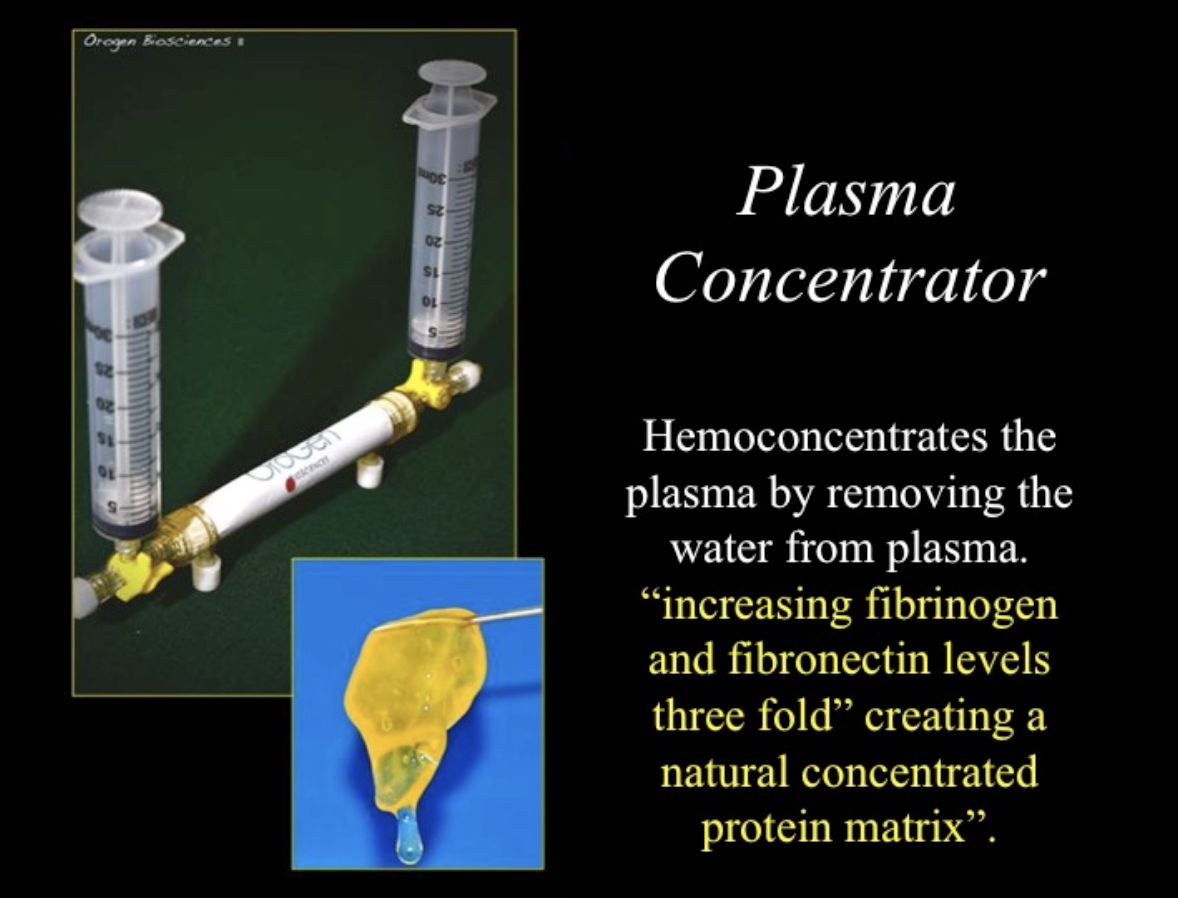
This is extremely important because our scaffold denser (as seen below, Right side). Since it is so dense, the entrapped anti-inflammatory cytokines and regenerative growth factors stay in the treatment area longer because it takes the body longer to assimilate this regenerative graft than a PRP or ACRS scaffold. Additionally, we can add MSC stem cells or Exosomes to this complex.
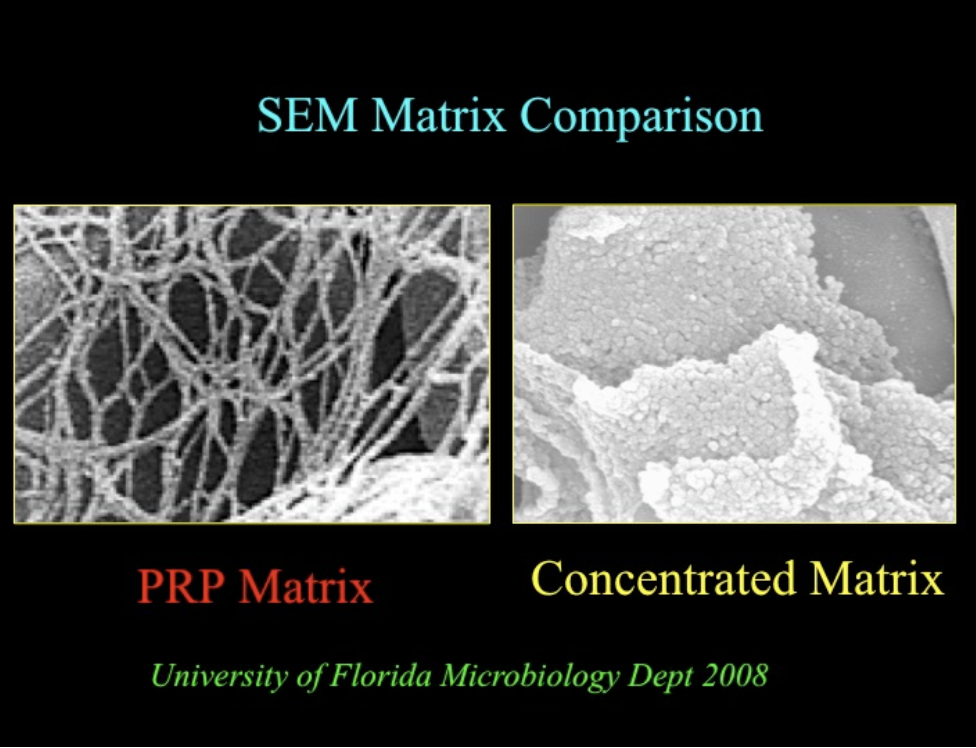
Our patient, below, demonstrates the regenerative healing of CRP/Natural Protein matrix on a burn patient. This burn injury required just two treatments and these are the results 48 days later…. The patient had no contracture of his hand, which usually follows a burn like this.
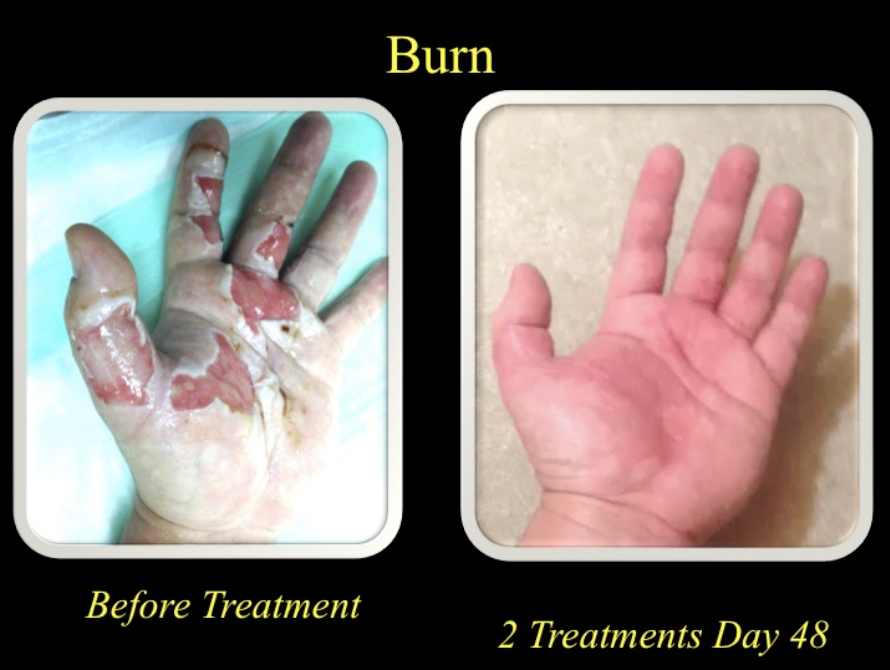
What is in Autologous CRP?
A wound healing and tissue regenerative composition as set forth in patent claim 20 in which, said growth factors essentially consisting of:
- platelet–derived epidermal growth factor
- platelet factor 4
- transforming growth factor beta acidic fibroblast growth factor
- basic fibroblast growth factor
- transforming growth factor A
- insulin-like growth factors 1 and 2
- B thromboglobulin-related proteins
- thrombospondin
- fibronectin
- von Willibrand’s factor
- fibropeptide A
- fibrinogen
- albumin
- plasminogen activator inhibitor 1
- osteonectin
- vitronectin
- fibran D – dimer
- factor V
- antithrombin III
- immunoglobulin-G
- immunoglobulin- M
- immunoglobulin- A
- a2-macroglobluin (Modifies Osteoarthritis)
- aniogenin
- Fg-D
- elasstase
- keratinocyte growth factor
- epidermal growth factor tumor necrosis factor
- fibroblast growth factor
- interleukin-1 antagonist (pain reduction)
- keratinocyte growth factor – 2
- and combinations thereof.
In Summary
- Our Autologous Cytokine Rich Plasma (ACRP) is more advantageous because:
- Our process is designed to capture a “higher amount of Growth Factors” compared to centrifuge methods used in PRP and ACRP.
- ACRP has only “Pure protein” (no RBC’s, no WBC’s) from the platelets and higher concentrations (3x) of the serum proteins …
- ACRP can “capture all the anti-inflammatory Cytokines “in minutes” where ACRS must incubated the patient’s blood 6 to 24 hours.
- ACRP has a much denser highly concentrated natural scaffold than PRP and ACRS to hold the healing cells in the treatment area longer.
